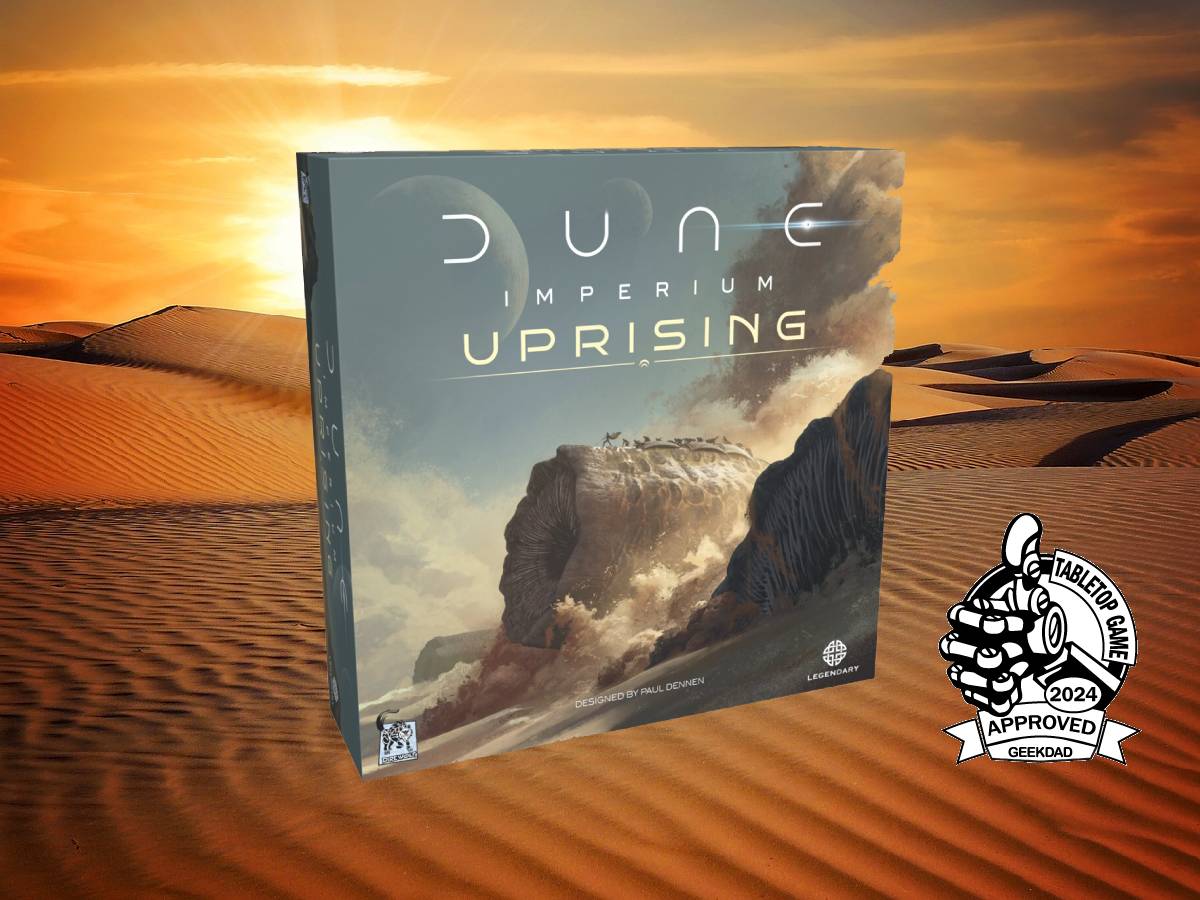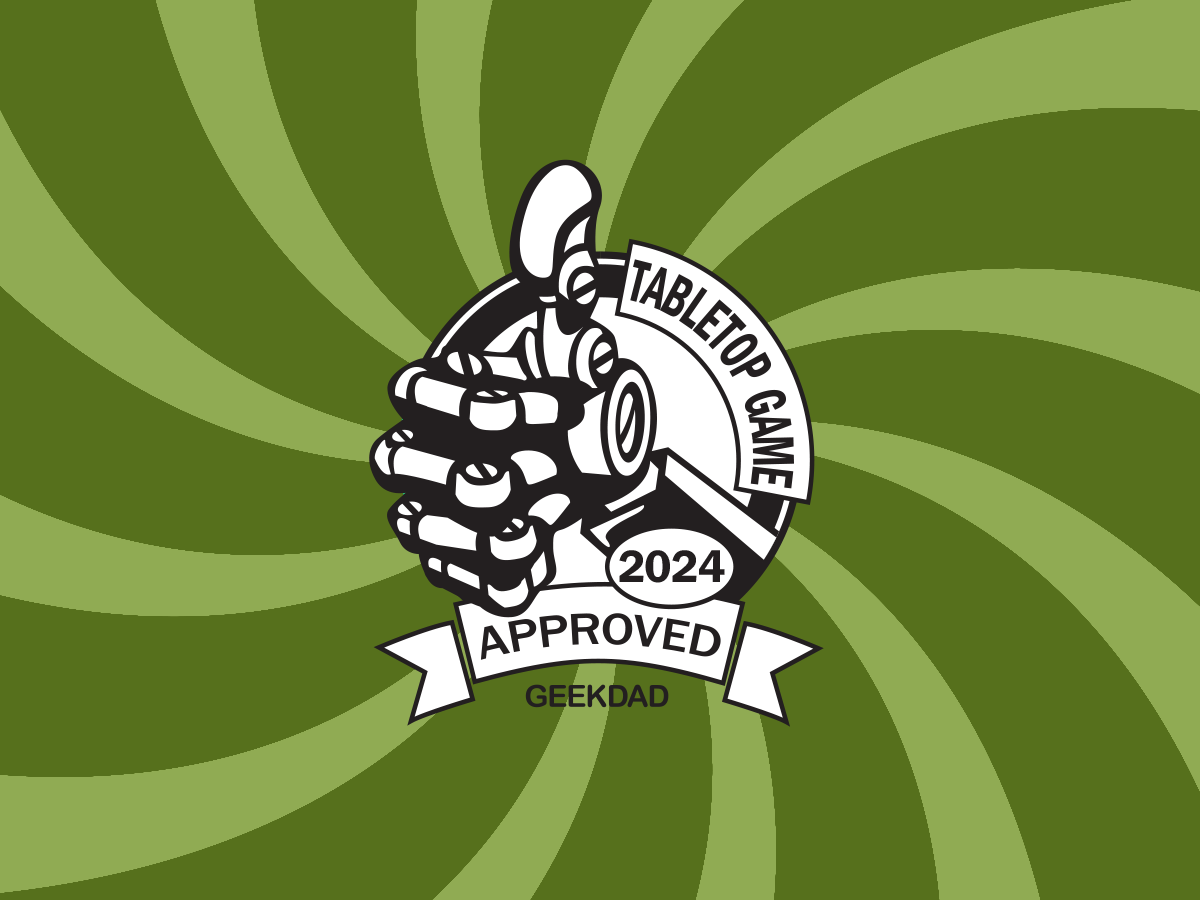Many of our readers are familiar with Dune: Imperium, the hit game from Dire Wolf that went on to become our GeekDad Game of the Year for 2021. That game was released alongside Denis Villeneuve’s Dune: Part 1, and covered the events of that film. Originally, Dune: Part 2 was scheduled to release in theaters in November 2023, but the actor’s and writer’s strikes of last year resulted in the film getting delayed until this coming March.
While Dune: Part 2 didn’t come out at the end of 2023, Dire Wolf surprised the gaming world with the release of Dune: Imperium – Uprising. I say surprised, because rather than being an expansion to Dune: Imperium, this game is a standalone sequel, which incorporates plot elements from Dune: Part 2. Normally I’d warn you about spoilers, but seeing as the movie is based on a novel that was originally published 1965, I’m pretty sure that statute of limitations has expired.
What Is Dune: Imperium – Uprising?
Dune: Imperium – Uprising is a deck-building game for 1-6 players, ages 13 and up, and takes about 60-120 minutes to play. While it works as a standalone game and does not require anything else to play, it’s compatible with the previous expansions to Dune: Imperium, and can also be combined with elements from the original base game. It contains rules for the standard game, the Rivals 1-2 player variant, and a six-player team game.
Dune: Imperium – Uprising was designed by Paul Dennen and published by Dire Wolf, with illustrations by Clay Brooks, Derek Herring, Raul Ramos, and Nate Storm. It retails for $60, and can be purchased from the Dire Wolf webstore or from Amazon.
Note: to differentiate between the original Dune: Imperium and Dune: Imperium – Uprising, I will at times use the abbreviations D:I and D:IU.
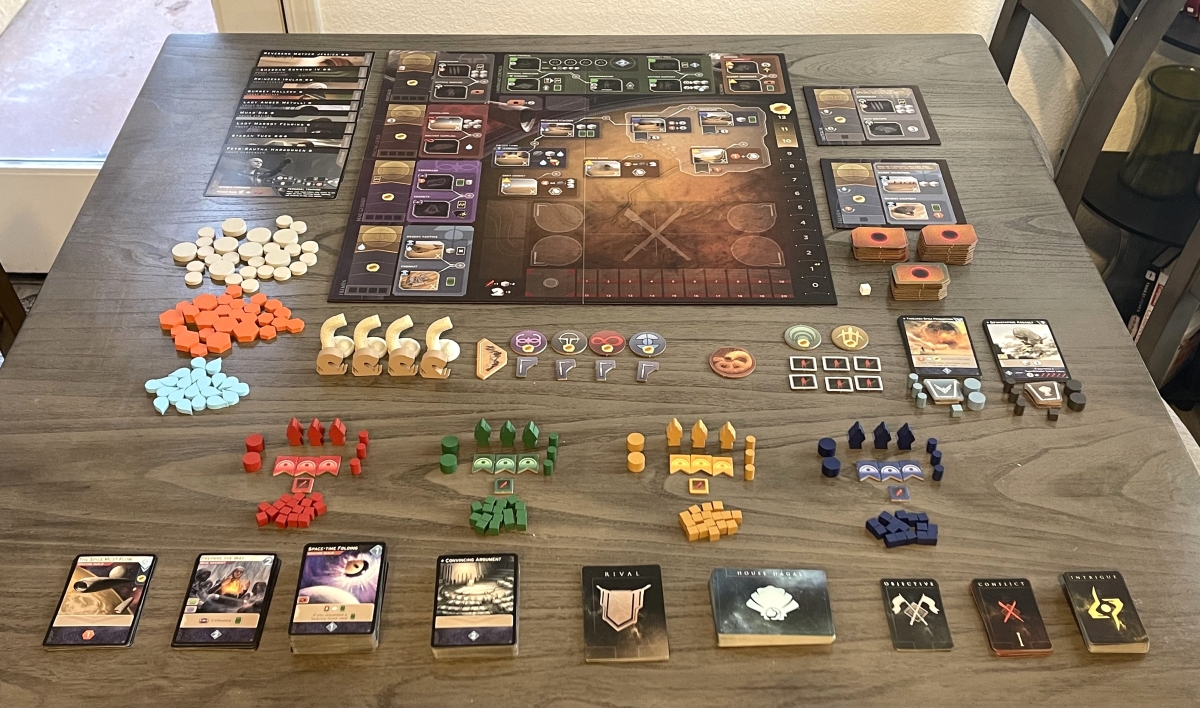
Dune: Imperium – Uprising Components
Many of the components, such as the wooden resource tokens, are identical to those found in the original Dune: Imperium. You can read about those in my review of that game.
The box contains the following components:
- Two-sided game board
- 20 Water tokens
- 28 Solari tokens
- 27 Spice tokens
- 4 plastic Sandworms
- 4 wooden Sandworms
- First player marker
- 6 Alliance tokens
- Shield Wall token
- 4 Maker Hook tokens
- 18 Reserve cards
- 9 Leaders
- 44 Intrigue cards
- Feyd token
- 69 Imperium Deck cards
- 16 Conflict cards
- 5 Objective cards
- (4) 10-card Starting decks
- 64 cubes
- 12 discs
- 18 Spies
- 12 Control markers
- 12 Agents
- 4 Combat markers
- 30 Contract tokens
- 6 Swordmaster Bonus tokens
- 6 Agent tokens
- 2 Faction cubes
- (2) 10-card Starting decks for 6-player games
- 2 Personal boards
- 37 House Hagal cards
- 10 Rival cards
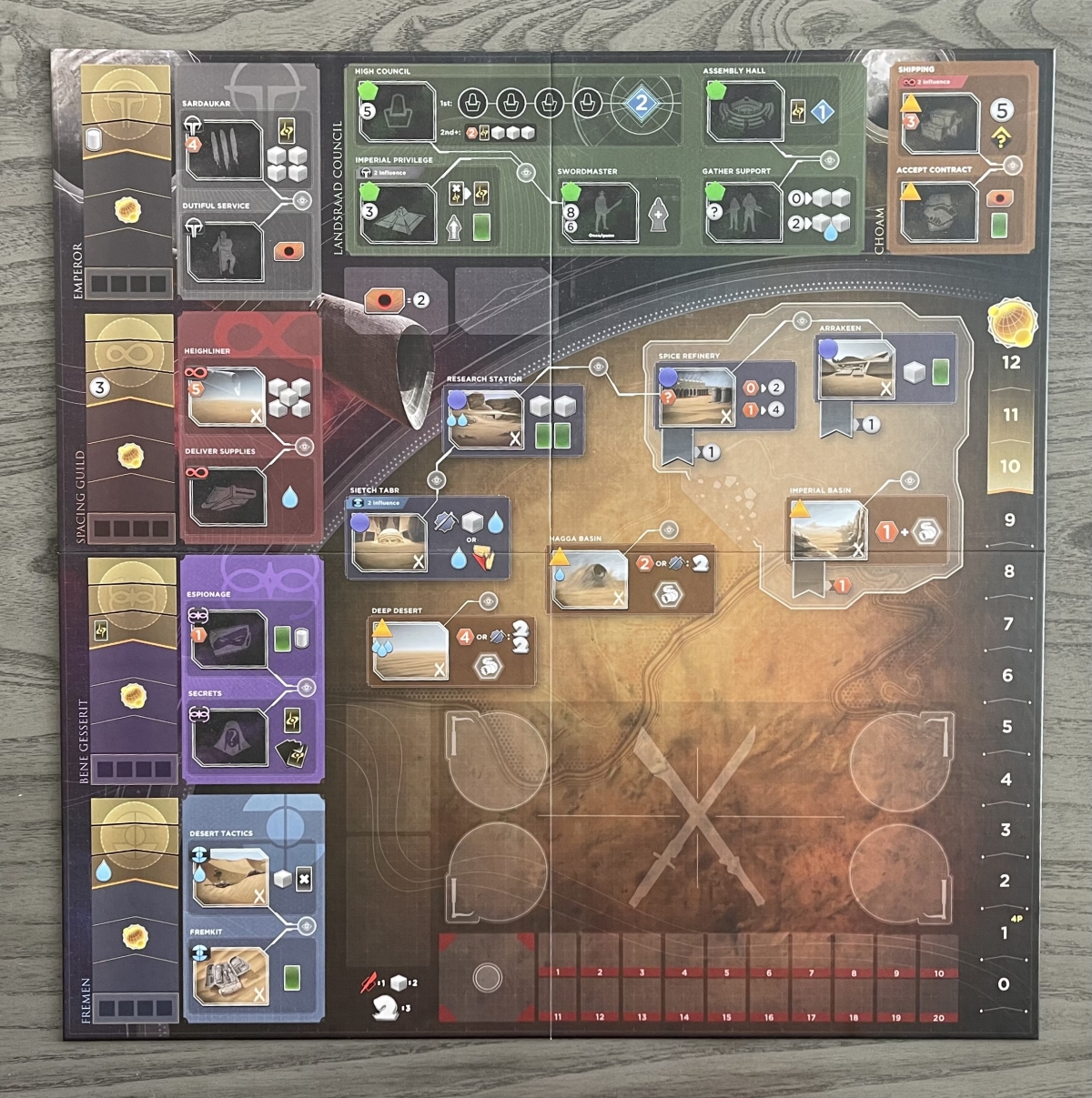
While the game board will immediately look familiar to previous players of Dune: Imperium, there are several notable changes which I will detail in the gameplay section of the review. The board is also double-sided, with one side dedicated to the 6-player team variant. That side has several changes from the 1-4 player side, notably replacing the Emperor and Fremen factions with Great House and Fringe World factions.
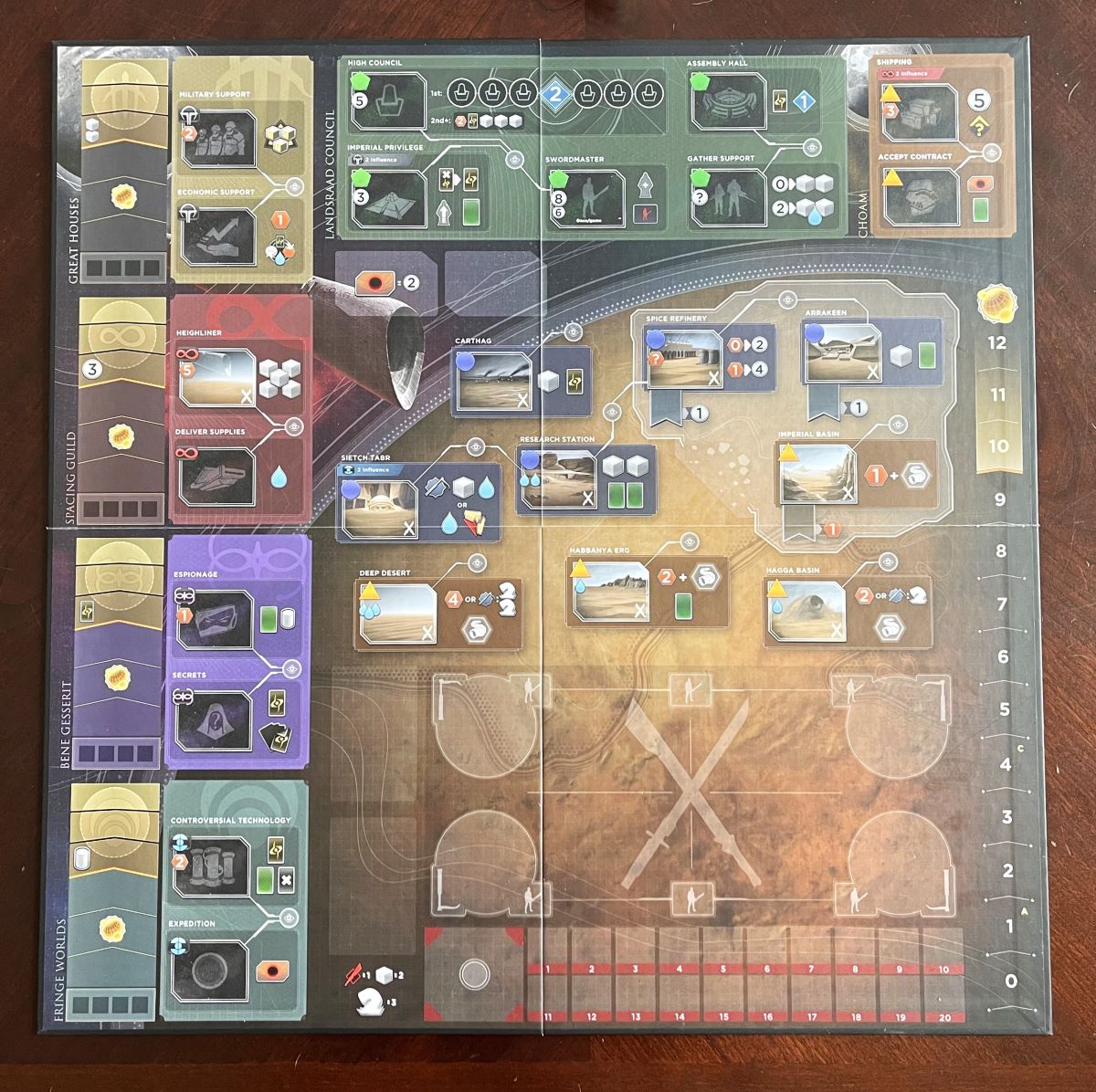
One of the new gameplay elements for Dune: Imperium – Uprising is Sandworms. These worms, which play an important role in Dune, can be recruited by players to assist in conflicts. They provide boosts to both combat power and Conflict rewards. The box contains both plastic and wooden versions, to match the components of both the base game, and the separate Deluxe Upgrade Pack.
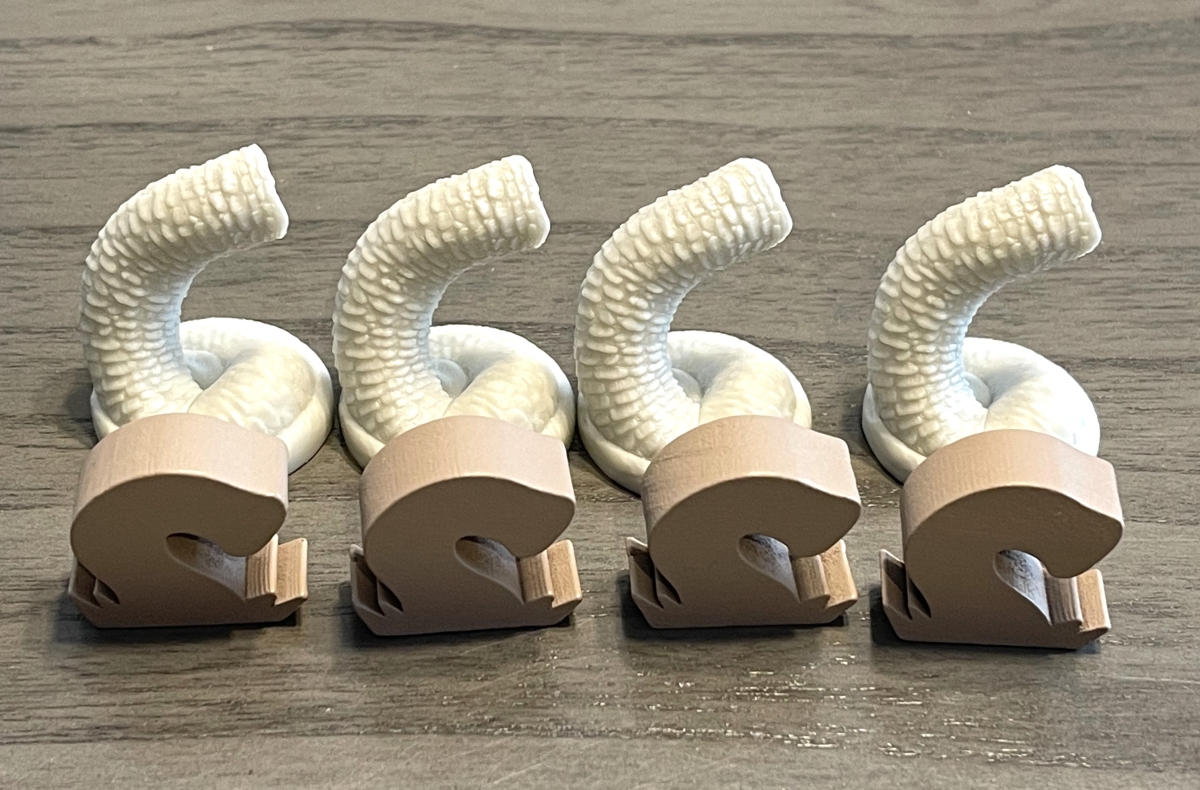
The game comes with 9 different playable leaders, each of which is marked to let you know how complex they are to play. Each leader has both a passive ability, and one that is triggered by playing the Signet Ring card.
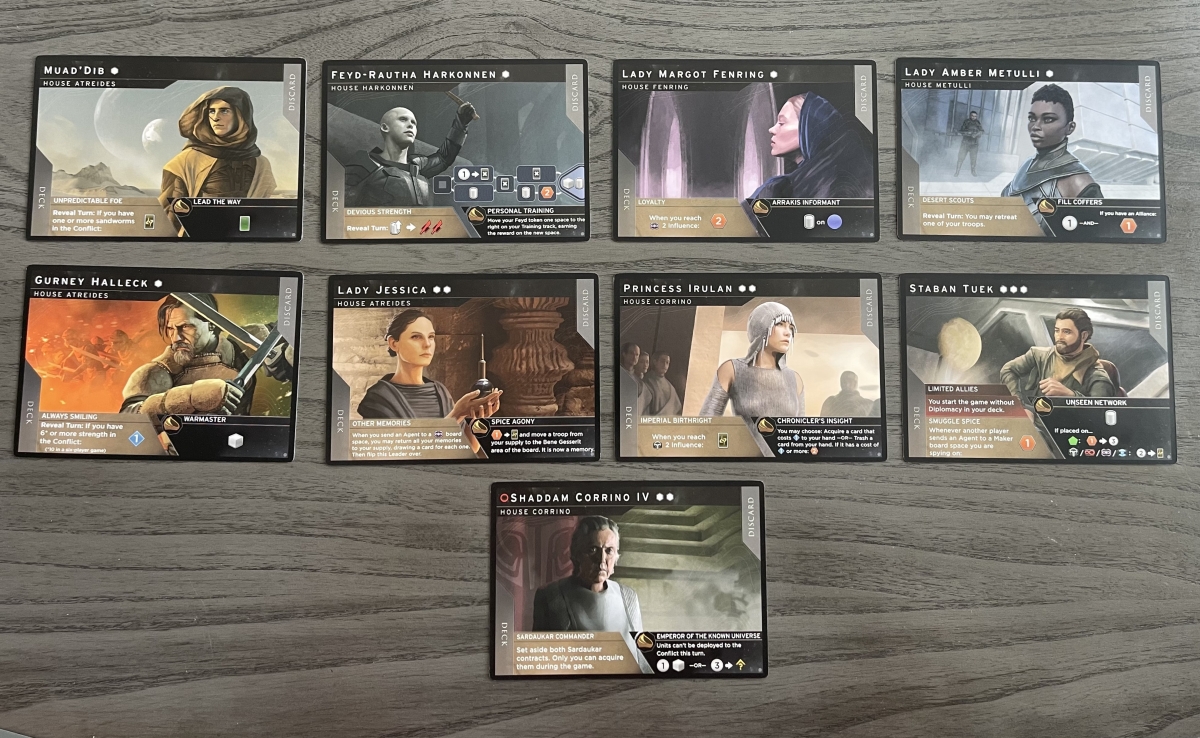
Of the 9 leaders, Emperor Shaddam Corrino IV is only playable when you also use the optional CHOAM module, which is included with the game.
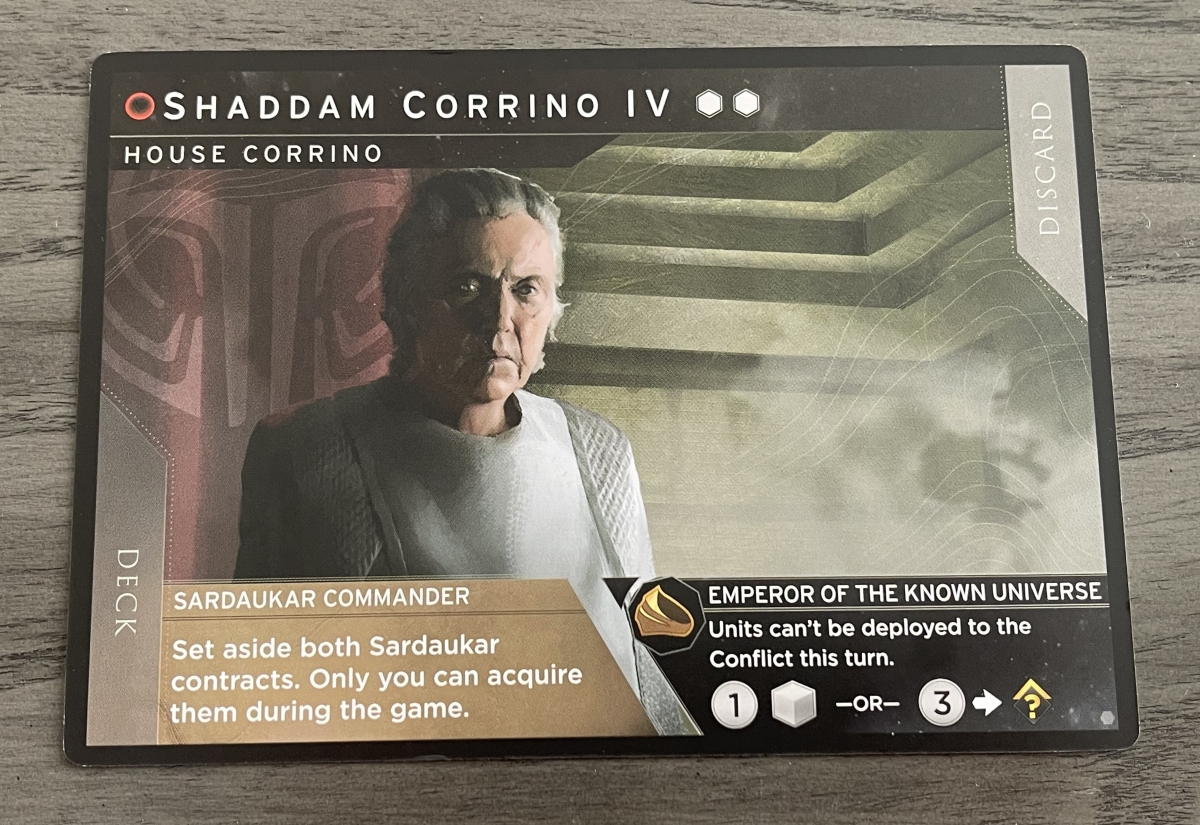
The CHOAM module largely consists of Contract tokens, which can be acquired when going to one of two spaces on the board. These contracts will pay out various rewards once their prerequisite has been fulfilled, such as going to a specific spot on the board. 10 of the Contract tokens are only for use when you are also using the Rise of Ix expansion.
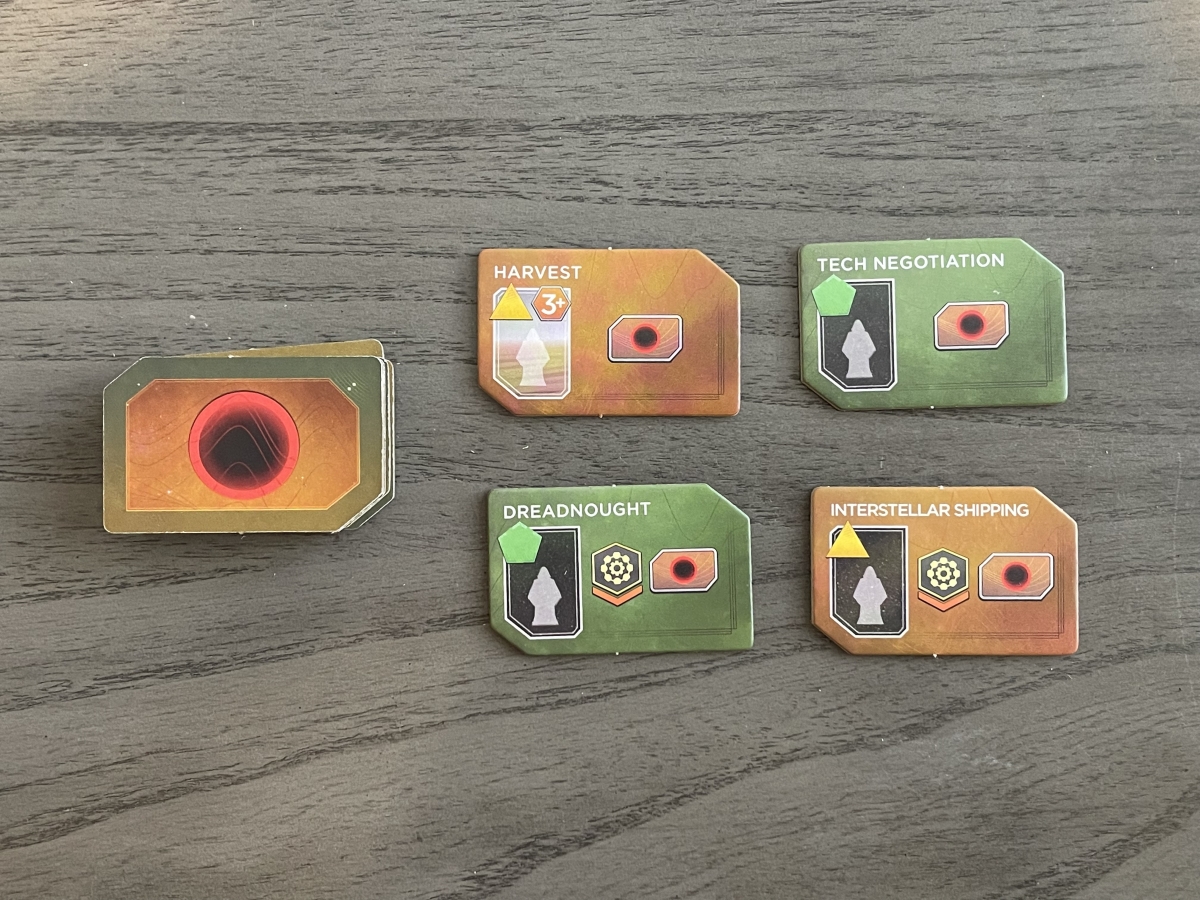
Many of the cards in the game will seem familiar at first glance to players of Dune: Imperium, but are definitely unique to Dune: Imperium – Uprising. For example, many of the Conflict cards offer rewards such as Contract tokens or the ability to place a Spy, which is another new mechanic of D:IU.
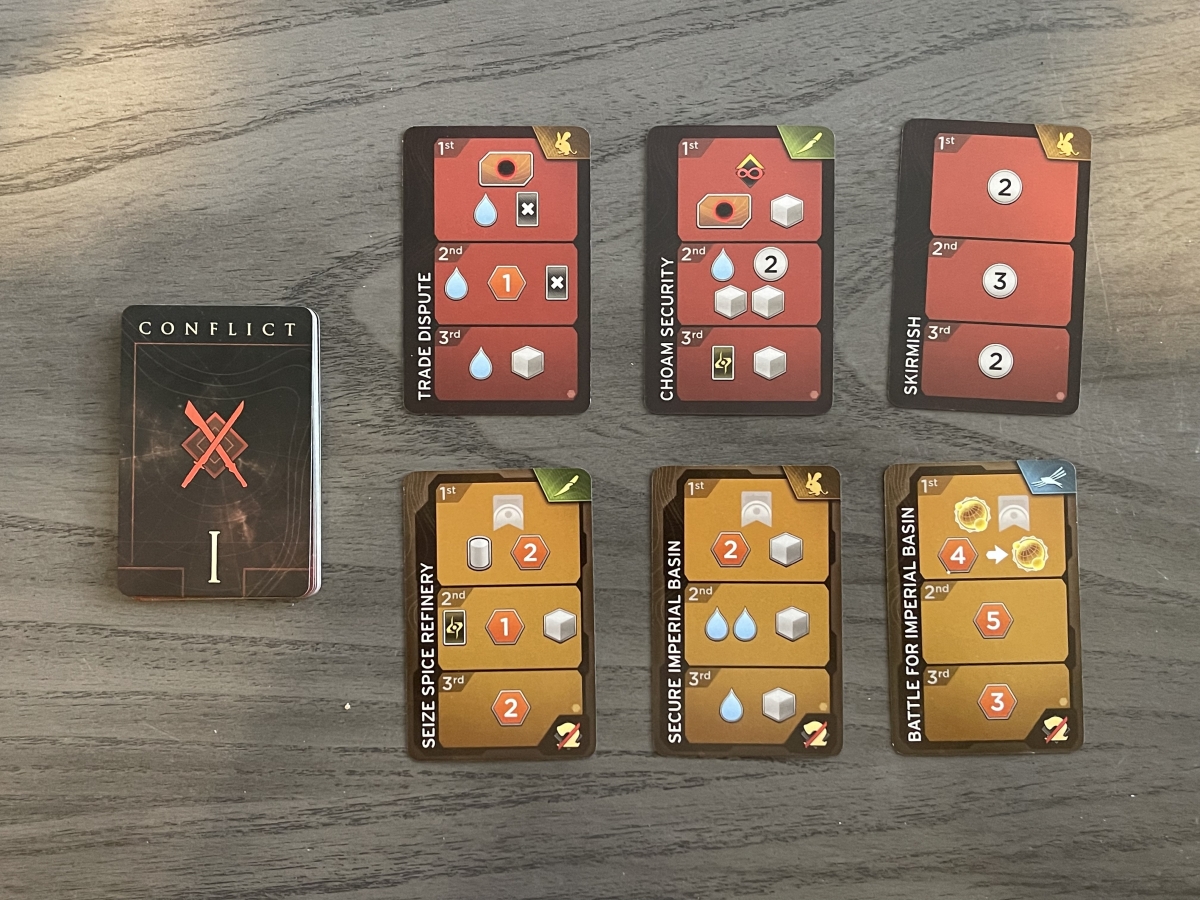
The Conflict cards each have one of three different symbols in the upper right corner. These symbols match the symbols on Objective cards, which are new to Dune: Imperium – Uprising. If you take 1st place in a conflict, and the symbol on that card matches the one on the Objective card that you drew at the start of the game, then you will earn a Victory Point.
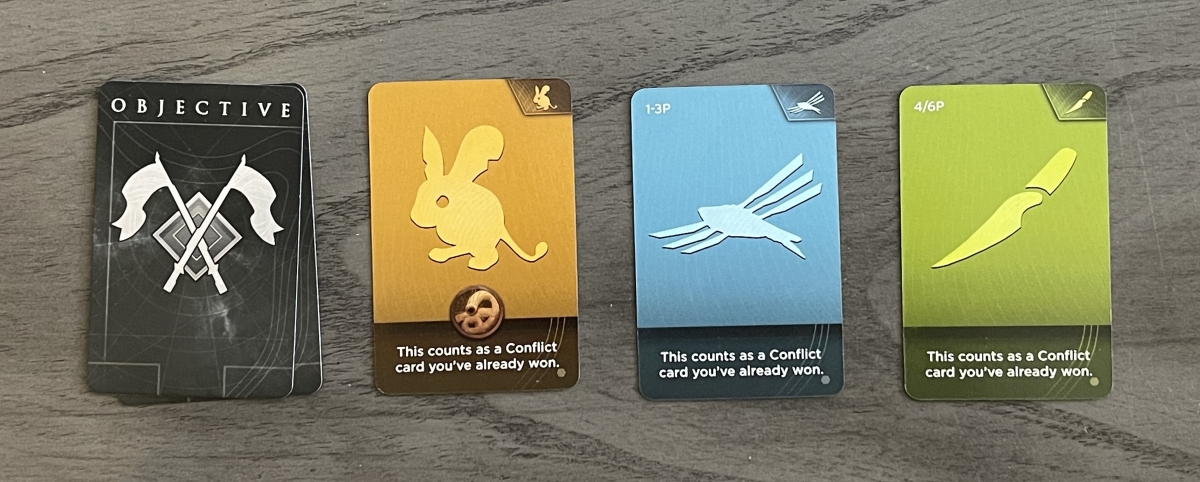
Dune: Imperium – Uprising comes with additional components for both the new six-player mode, and the Rivals solo and two-player games. The six-player games are team games, and players will not choose any of the leaders but instead will be on either the Fremen or the Emperor team. Each team comes with its own unique player board, starting deck, and other components.
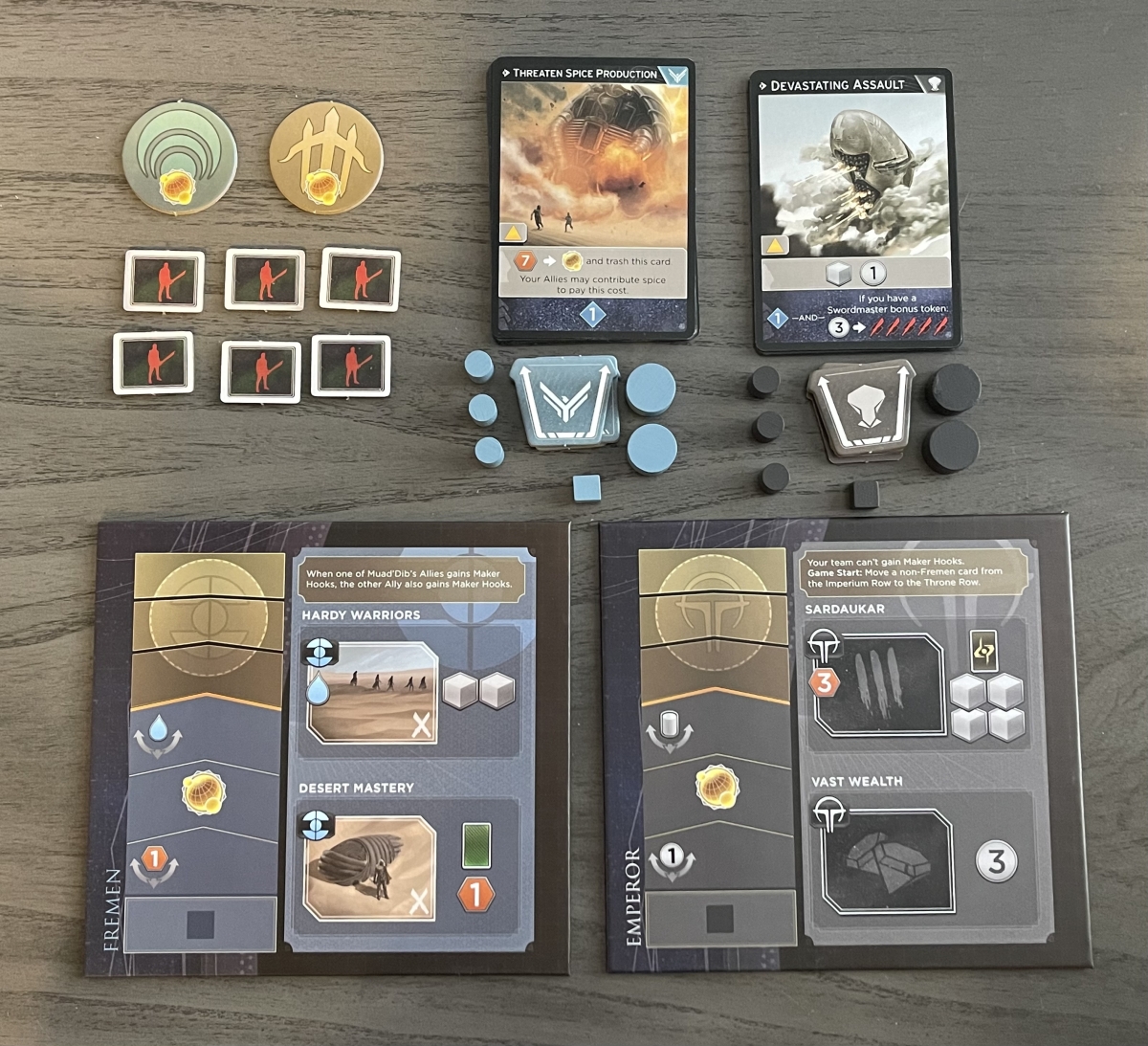
How to Play Dune: Imperium – Uprising
You can download a copy of the main rulebook here.
This review will mainly cover the rules and gameplay for the standard version of Dune: Imperium – Uprising.
The Goal
The goal of Dune: Imperium – Uprising is to be the player with the most Victory points once play has ended.
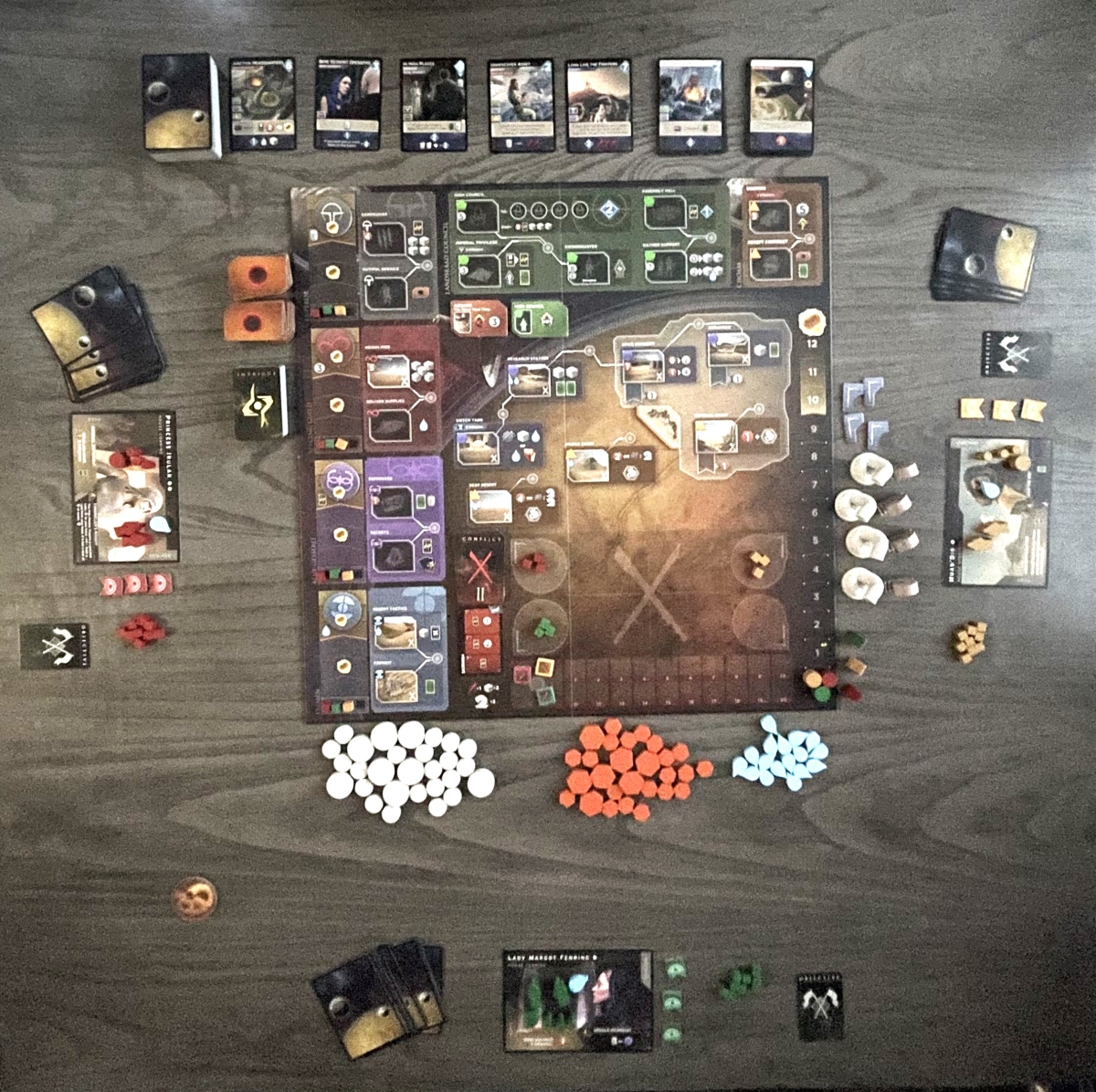
Setup
Place the game board with the 1-4 player side up, and place the Shield Wall token on the marked area. Place the 4 Alliance tokens on the marked areas of the Faction’s influence tracks.
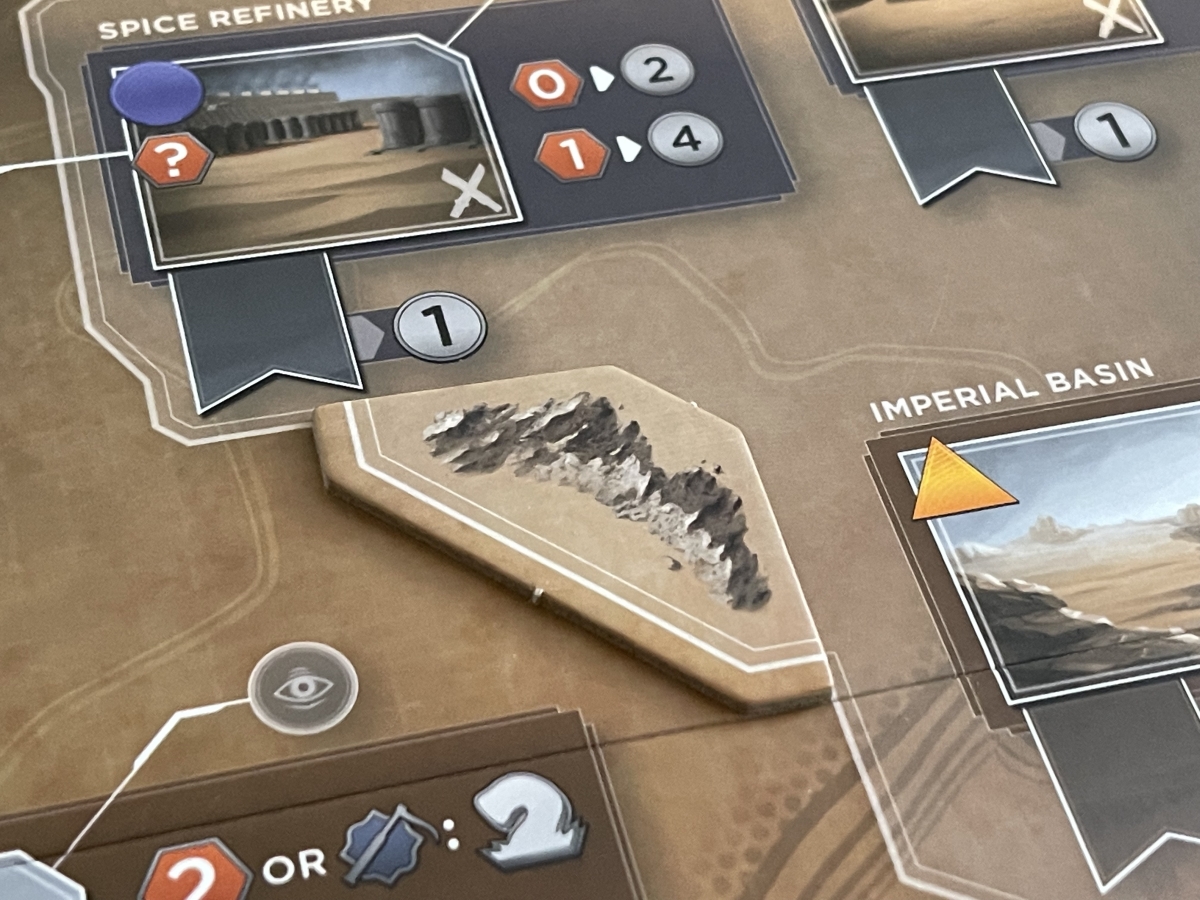
Create a Conflict deck by:
- Shuffling the Conflict III cards and placing all face down on their space on the game board.
- Shuffling the Conflict II cards and dealing 5 face down on top of the Conflict III cards.
- Shuffling the Conflict 1 cards and dealing 1 on top of the Conflict II cards. Then return all unused cards to the box.
Shuffle the Intrigue cards and place it face down near the board. Shuffle the Imperium deck, place it face down, and deal 5 cards face up next to it to form the Imperium Row.
Next to the Imperium Row, place the stacks of Prepare the Way and The Spice Must Flow cards. Create a bank of water, Solari, Spice, Sandworms, and Maker Hooks, and keep these within easy reach of all players.
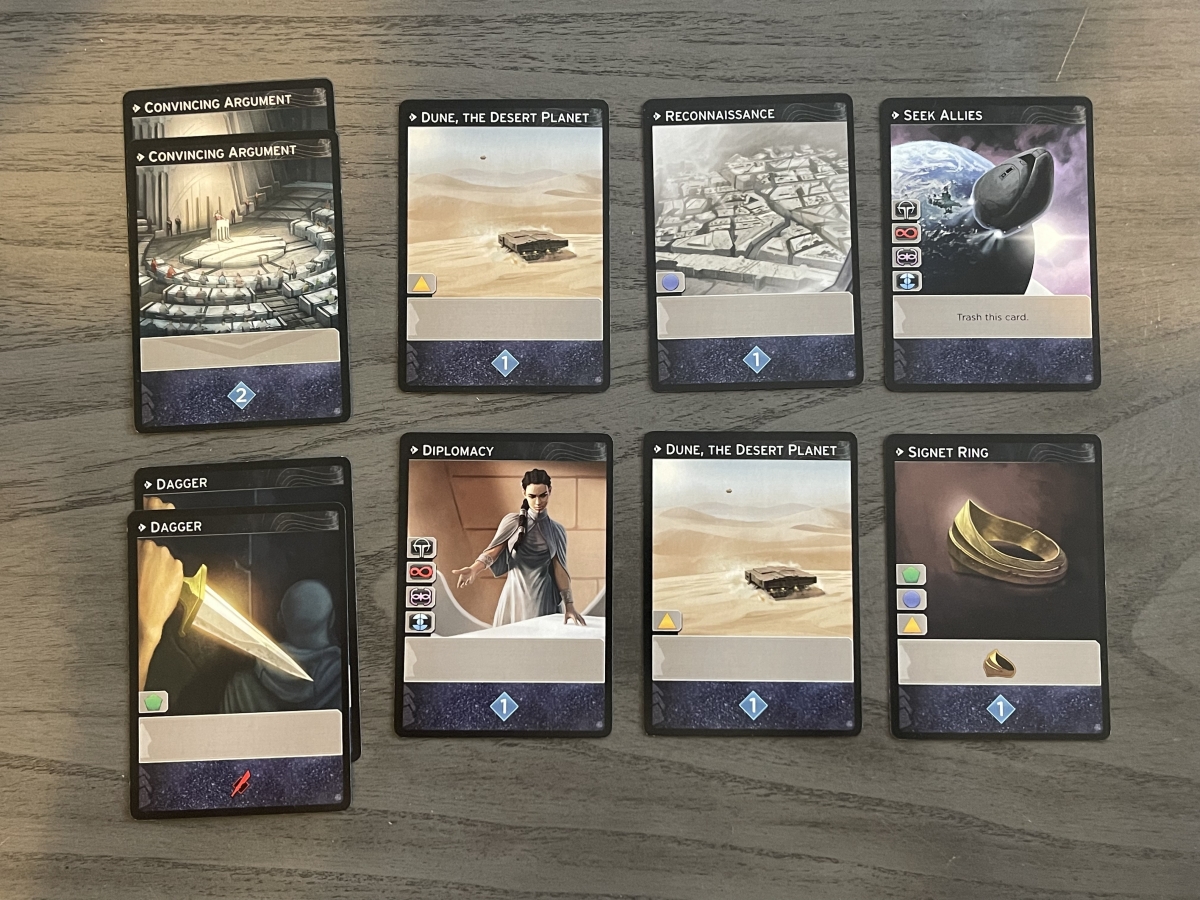
Each player chooses a Leader and places it in front of them. They take a 10-card starting deck, shuffle it, and place it face down the left of their Leader. Each player takes 1 water from the bank and places it on their supply. Finally, each player chooses a color and takes all of the matching components.
Players then:
- Place 2 of their Agents on their Leader, and the third next to the game board.
- Place one of the two discs on the 0 space of the score track, or on the 1 space if playing a 4-player game.
- Place the Combat marker on the 0 space of the Combat track.
- Place 4 cubes, one each, on the bottom spaces of the influence tracks of the four Factions.
- Place 3 cubes into the circular garrison on the game board closest to where they are sitting.
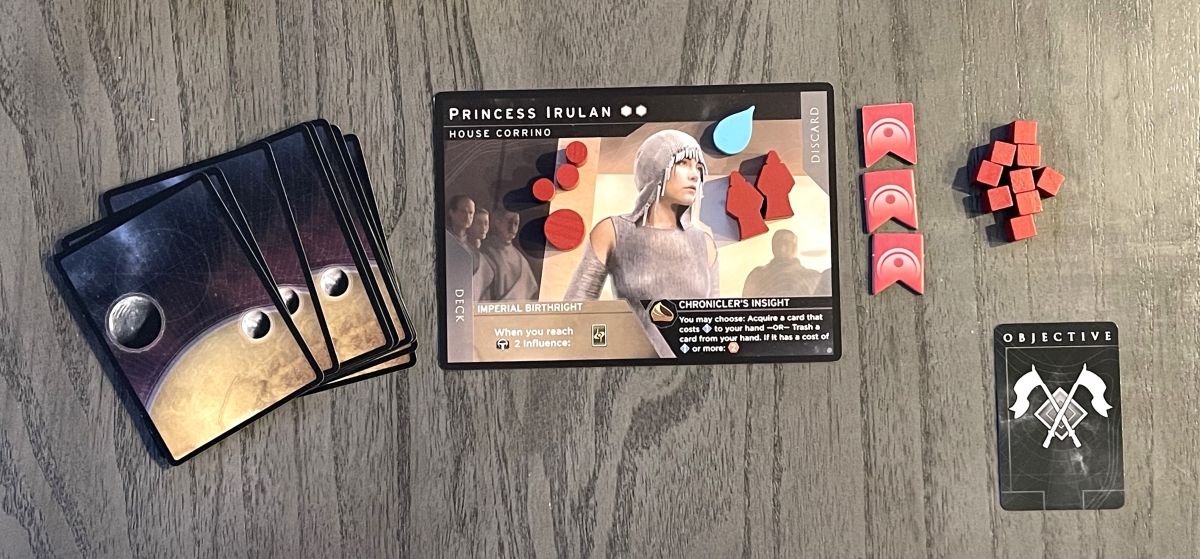
Finally, shuffle the Objective cards, omitting any that don’t match the player count. Each player draws one Objective card at random and places it face-up in their supply. The player whose Objective card shows the First Player marker takes the marker, and will start the game.
Gameplay
Phase 1: Round Start
Flip over the top card in the Conflict deck and place it face up next to the deck. This shows the rewards available for the Conflict for this round, as well as which location you will be battling over.
Each player then draws five cards from their own deck to form their hand for the round.
Phase 2: Player Turns
Beginning with the First player and going clockwise, each player will take either an Agent turn or a Reveal turn. A player’s Reveal turn will always end this phase for that player.
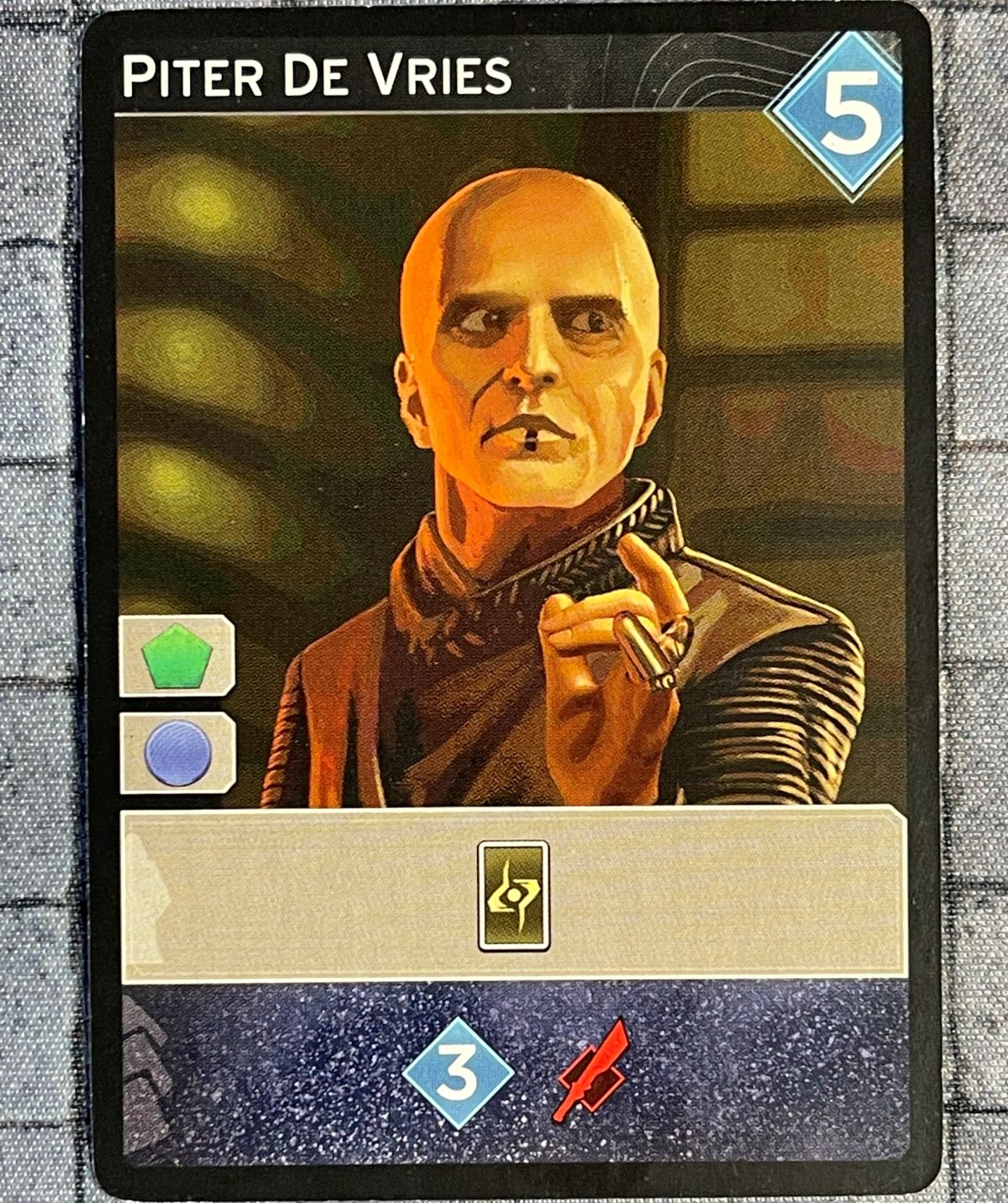
Each card that goes into your deck can be used in either the Agent turn or the Reveal turn, but not both. The areas with the sand background show you which spaces you can send an agent to, as well as an additional effect that the card provides. In the original Dune: Imperium card above, Piter can go to any open areas with the matching symbols on the card’s left side (though some of these areas will have additional costs, as indicated on the space itself). Additionally, playing this particular card during the Agent turn will allow you to draw an Intrigue card.
Intrigue cards come in three types: Plot, which can be played during your Agent or Reveal turn; Combat, which can be played during the Combat phase; Endgame, which can only be played at the end of the game. In Dune: Imperium – Uprising, there are also some multi-use Intrigue cards, as you can see below.
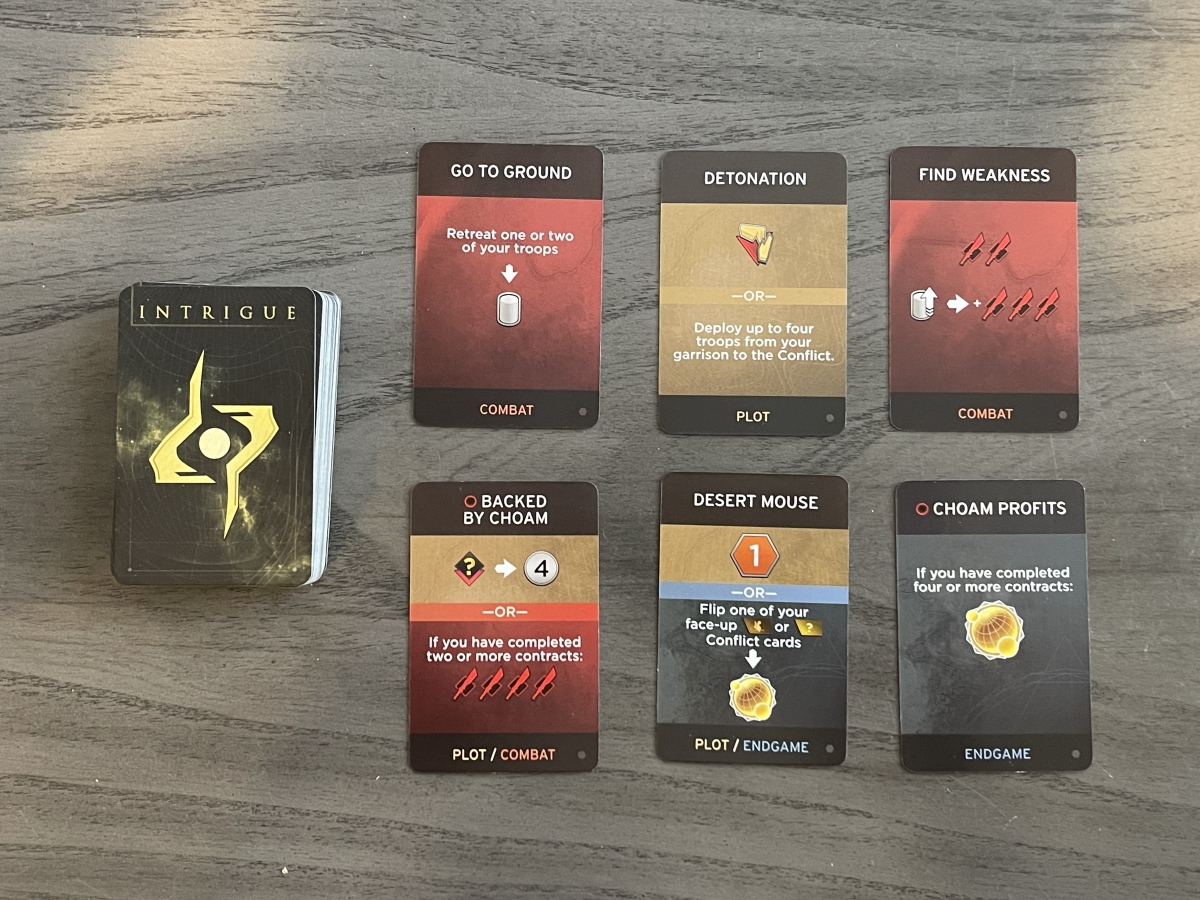
Sending your Agent to a space will also give you whatever rewards are shown at the particular space, or might allow you to take certain actions, such as selling Spice to gain Solari.
If you send an Agent to a space with any of the four Factions, you will not only gain the indicated rewards, but move your cube up a space on the Faction Influence track. You also gain any reward that’s on a space that your cube moves into, such as a Victory Point. The first player to reach the Influence token takes that token and gains another Victory Point. However, if another player passes that person on the same track, then they will take the token from that player, gaining a Victory Point (and the original player will then lose that point they had gained).

When the cube icon appears at a space you send your Agent to, you take a cube from your supply (representing a troop) and place it in your garrison on the Game board.
If the space you send your Agent to shows crossed swords, then you may deploy any troops you recruit that turn to the Conflict, which is the large crossed swords area between all four garrisons. You may also send up to two additional troops from your garrison to the Conflict.
Once you have deployed all the Agents that you can or want to deploy, then it’s time for the Reveal turn. At this point, you lay out the rest of your hand, and receive the effects shown in the bottom box of those cards. Most often, you will be gaining either Persuasion or Combat Strength.
Persuasion are numbers in blue diamonds. These are used to either purchase cards from the Imperium Row, or buy one of the Reserve cards. The costs for those cards is at the top right of the card, also in a blue diamond. After purchasing one of the five cards from the Imperium Row, a new card is immediately drawn from the Imperium Deck to replace it in the Row.
Combat Strength are the sword symbols. If you have any troops in the Conflict, then you will set your strength on the Combat Track as follows: each troop is worth 2 strength, and each sword on a revealed card is worth 1 strength (this is also shown on the Game board). Move the Combat marker to the appropriate spot on the track.
Discard all the cards from your Agent and Reveal turns. Once all players have finished their Reveal turns, then move on to the next phase.
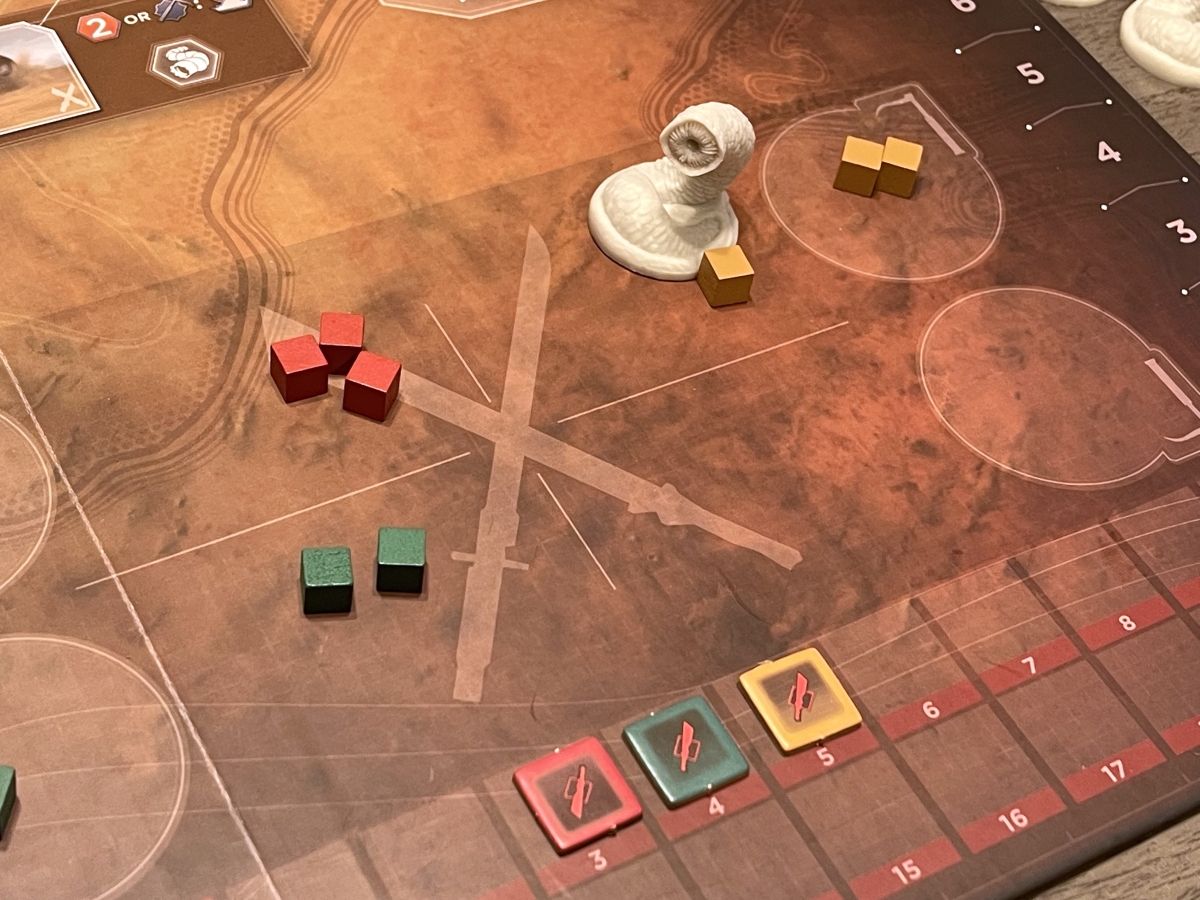
Phase 3: Combat
In Dune: Imperium – Uprising, you can now recruit Sandworms to fight for you. Each Sandworm has 3 combat strength. However, it is also important to note that you may not use Sandworms in any of the 3 conflict locations that are behind the Shield Wall, until the Shield Wall has been taken down. Taking down the Shield Wall can either be done by visiting the Sietch Fabr space on the board during an Agent turn, or via certain cards in the game. Similarly, to recruit a Sandworm you must first have acquired a Maker Hook, and then visit a location or play a card that will allow you to recruit one or more Sandworms for that turn.

Beginning with the First player, each player may play any number of Combat Intrigue cards, or pass. Different Combat Intrigue cards may allow you to add strength to your combat, retreat troops, or even remove any troops.
Once all players in Combat have passed consecutively, then you resolve the Combat. The player with the highest strength wins the top prize on the Conflict Card, and second-highest gains the second reward. The third reward is only awarded in 4-player games.
If players tie for first place, no one wins the Conflict, but instead the tied players all receive the second reward. Players that tie for second place receive the third reward. Any players with Sandworms in the Conflict double their reward. Finally, the winner of 1st place takes the Conflict card, and if it matches with another face-up Conflict card they have previously obtained or with their Objective card, then that player gains 1 Victory Point.
At the end of the Combat, all troops are returned back to player’s supplies rather than their garrisons, and all Sandworms are returned to the general supply.
Phase 4: Makers
If any of the three spaces with a Maker icon (the Sandworm) don’t have an agent on them, put a Spice token onto those spaces. Multiple bonus Spice tokens can build up there, but will be taken by a player once their Agent is placed on that space during a future Agent turn.
Phase 5: Recall
If any player is at 10 or more Victory Points, or if the Conflict Deck is empty, then Game End is triggered. If this is not the case:
- Players recall their Agents.
- Pass the First Player marker to the next player clockwise, and start again with Phase 1.
Game End
Play and resolve any Endgame Intrigue cards. Then, whoever has the most Victory Points is the winner.
Tiebreakers are, in order, amounts of: Spice, Solari, Water, and garrisoned troops.
Additional Dune: Imperium – Uprising Mechanics: Spies
The biggest change from the original Dune: Imperium comes in the form of Spies. Whenever a Spy icon appears on a card (they look like a cylinder) you may place a Spy from your supply onto an unoccupied observation post. These posts are connected to one or more locations on the board, and there are multiple observation posts across the game board.
When a Recall Spy icon appears on the card (a cylinder with an “up” arrow), you can recall your spy to gain the effect shown on the card.
You may also recall a spy without using a Recall Spy icon for one of the following effects:
- Infiltrate: go to a board space currently occupied by another player.
- Gather Intelligence: go to a board space connected to the observation post, recall the Spy, and draw a card.
In the example below, the gold player is able to go to Sietch Tabr even though the red player had gone their earlier. They would then remove their spy from the observation post and return it to their supply.

Additional Dune: Imperium – Uprising Mechanics: CHOAM Module
As discussed earlier, the CHOAM Module is an optional mini-expansion that you can easily add into your games of Dune: Imperium – Uprising. During setup, you shuffle the Contract tokens, place them face down next to the board to form a deck, and then place two face up in their spaces on the game board.
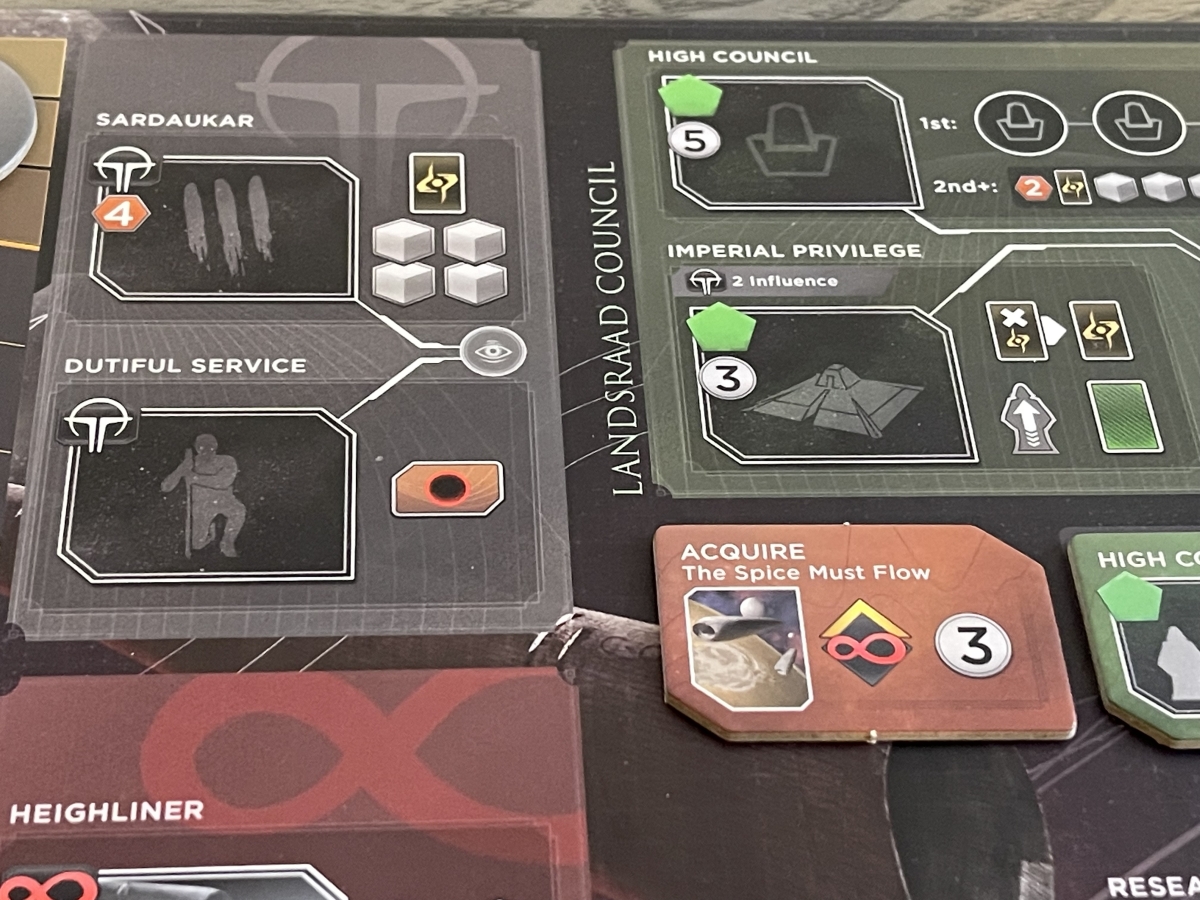
When a player goes to the Dutiful Service or Accept Contract locations, they may take either of the two Contracts on the game board and place it in their play area. After they have chosen, it is immediately replaced by another from the Contract deck. If all Contracts have been taken, then anyone going to that location instead receives 2 Solari, which is the same as what a player would receive going there when not using the CHOAM Module.
Contracts are completed when you have done the action specified on the Contract. At that point, you announce that they are completed, take the designated reward, and flip the Contract face down.
There are three different types of Contracts:
- Harvest: Send an Agent to a Maker board space and gain the amount of spice shown during that turn.
- Immediate: Completed as soon as you take the Contract.
- Acquire: You must acquire the card The Spice Must Flow.
It’s pretty much a no-brainer to always incorporate the CHOAM Module into your games. The additional setup is minimal, and it adds another strategic tool to players’ arsenals. It also provides an interesting alternative to simply going to a space and earning 2 Solari.
Additional Game Modes
For rules on how to play the Rivals or six-player games, click here to download the rulebooks.
Rivals – Solo & Two-Player Games

For Dune: Imperium – Uprising, designer Paul Dennen has revised the rules for playing one and two-player games. There is now a Rivals deck, from which you will select a two Rivals if you are playing solo, or just one if you are playing a two-player game. The House Hagal deck is used to direct the placement of the Rivals’ agents.

The solo and 2-player mode was already strong in the original game, but this new Rivals mode works even better.
Six-Player Games
The six-player game rules has two teams playing against each other. Each team has a Commander, and two allies. The Commanders are Muad’Dib and Emperor Shaddam Corrino IV, and their allies can select leaders as normal from the remaining Leader cards. In addition to their Leader cards, during setup the Commanders will also take their respective personal boards.

There are several gameplay concepts and mechanics that are unique to a six-player game. I haven’t had a chance to play Dune: Imperium – Uprising with six people, so I can’t comment on how well the game mode plays. The majority of D:IU players will likely play just the standard game or the Rivals mode, so I won’t be going into any detail on six-player games. However, if you’re interested in this mode, I recommend reading the six-player rules.
Dune: Imperium – Uprising is GeekDad Approved!
Why You Should Play Dune: Imperium – Uprising
Three years and a handful of expansions later, and here we have Dune: Imperium – Uprising. As you can see from reading my original review of Dune: Imperium, D:IU plays similarly… so much so, that much of the gameplay section of the review was taken from my D:I review and modified for the new mechanics. So, why does Dune: Imperium – Uprising deserve its GeekDad Approved rating, and should you buy it if you already own Dune: Imperium?
In regards to the first question, Dune: Imperium – Uprising first and foremost has all of the great core mechanics that made Dune: Imperium such a great game. However, D:IU doesn’t rest on its laurels. The game incorporates new mechanics that reflect the story developments in the upcoming movie Dune, Part 2. For example, players that gain influence with the Fremen faction are able to first learn how to ride Sandworms, and then lead them into battle. But in the later battles, they will only be able to use those Sandworms if they have first taken down the Shield Wall.
There are also a number of other new mechanics that feel highly thematic for the Dune universe, even if they don’t tie quite as directly to the upcoming film. The CHOAM module provides players with additional ways to gain rewards. But of course, grabbing a Contract means dedicating one of your Agents that round to picking it up, instead of using the capabilities of other locations. It’s a great way to add additional options for players without being overwhelming or overpowered.
The incorporation of Spies is well-implemented, and also fits right into the Dune theme. After all, the original Dune: Imperium not only had an Intrigue deck, but also one of the leaders of that game could infiltrate certain locations. In this case, all players are on equal footing with their use of spies. I found the Spies to be a fantastic addition to Dune: Imperium – Uprising, as they have multiple uses and, if played with forethought, can keep you from getting locked out of a vital location when you need it most.
Paul Dennen has made several little tweaks to gameplay in D:IU from the original Dune: Imperium. One that immediately leaps to mind involves acquiring the Swordmaster. In D:I, you go to the Swordmaster space, pay 8 Solari, and acquire your third agent. But in Dune: Imperium – Uprising, only the first player to use that space pays 8 Solari, with each subsequent player paying 6 instead. So it becomes a mini-game of who will blink first and pay the larger amount.

Similarly, the High Council space has seen a change. This location, much as in Dune: Imperium, allows players to buy a council seat for 5 Solari and gain an additional 2 Persuasion each round. But in Dune: Imperium – Uprising, you can actually return to that location on a subsequent turn for a fantastic benefit: you gain 2 Spice, draw an Intrigue card, and recruit 3 troops. Now there’s an added impetus to not only use that location, but to do so early so that you can reap the benefits from return visits.
With both the new and tweaked mechanics, Dune: Imperium – Uprising is a fantastically tight gaming experience with a lot of strategic options for players to plan their way to victory. As such, it’s definitely deserving of GeekDad Approved. And the experience of playing the game is both comfortably familiar to players of Dune: Imperium, and surprisingly different in several respects.
So now we turn to the more difficult question: if you already own Dune: Imperium, should you purchase Dune: Imperium – Uprising? And my answer to that one is… maybe?
The original Dune: Imperium was, and is, a superb game, and well worth owning. It becomes even better once you incorporate the Rise of Ix expansion. If you’re already heavily invested in the first game, I can understand why you’d be hesitant to purchase a standalone sequel. However, Paul Dennen made sure that Dune: Imperium – Uprising is compatible with all the previous expansions for Dune: Imperium. You can even incorporate some elements of the Dune: Imperium base game into games of Dune: Imperium – Uprising if you wanted to. So purchasing D:IU doesn’t end up replacing a game ecosystem you’ve already bought into. And, if you want to play a six-player team game, Dune: Imperium – Uprising is the only way to go.
If you don’t own either, that’s a much easier answer. I would purchase Dune: Imperium – Uprising. Out of the box, it’s a bit more refined than the original game, and offers more choices for players . Dune: Imperium – Uprising additionally offers a mini-expansion with the CHOAM Module, and that 6-player mode which will be welcome to player groups of that size. I love the new mechanics in Dune: Imperium – Uprising, and when I think about playing games of Dune, that’s the one that I’m currently thinking about grabbing off the shelf.
For more information or to make a purchase, visit the Dire Wolf Store.
Click here to see all our tabletop game reviews.
![]() To subscribe to GeekDad’s tabletop gaming coverage, please copy this link and add it to your RSS reader.
To subscribe to GeekDad’s tabletop gaming coverage, please copy this link and add it to your RSS reader.
Disclosure: GeekDad received a copy of this game for review purposes. As an Amazon affiliate, I may earn a small commission on qualified purchases.
